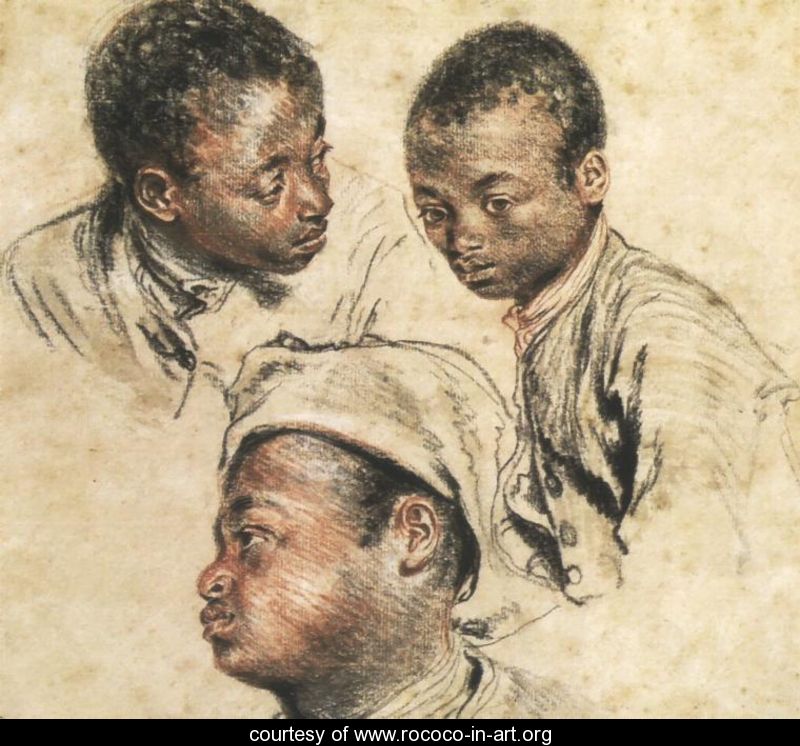WATTEAU:EMBEDDED LANGUAGE AS AN ART OF LIVING
There is always two contradictory dimensions which Watteau’s paintings contain. On the one hand there is melancholy pleasure signifying sadness, the metaphysics of pleasure; on the other hand, a libertine pleasure without any metaphysical meaning, pleasure which signifies only itself: a tension between a lost idyllic past and a subversive utopia.
Watteau was the artist who revised French painting, shifting it quite suddenly from the seventeenth-century formalism of Poussin and Le Brun to a kind of parisian Frenchness that has ever since been a steady dominant in French art. It is a Frenchness best understood by most people in the art of Renoir, a Frenchness where gaiety and tenderness are perfectly matched, where casual diversions are understood as manifestations of the good things that each individual experiences, or hopes to experience, within the intimacy of his own life.
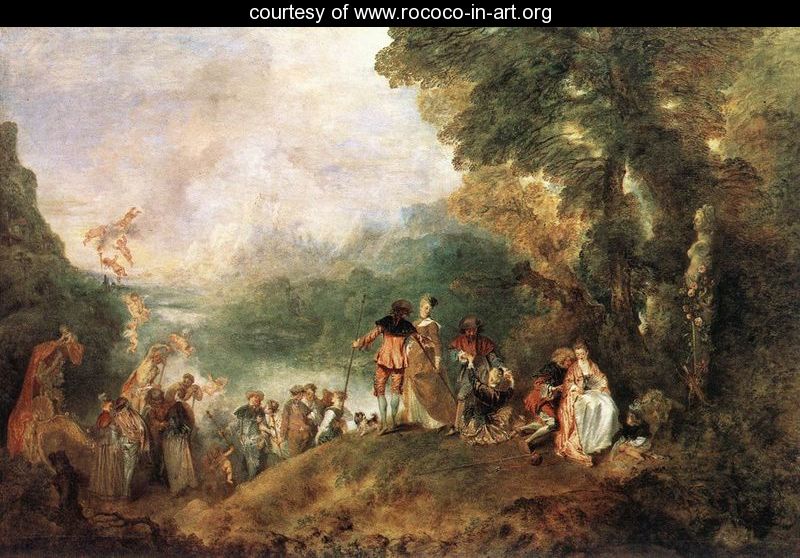
Embarkation for Cythera. Cowart: interpretation is based on evidence from an unlikely source for subversion: the opera-ballet performed at the Academie Royale de Musique (the Paris Opera). Like Watteau's fetes galantes, this genre has been linked to the frivolity and degeneracy of an aristocratic elite. Yet a careful study of specific works, along with their parodies at the Comedie-Francaise and the popular theaters of the foire, reveals how the opera-ballet sets up a discourse of subversion successfully engaging a discourse of absolutism found in the entertainments of Louis XIV's early court. Two works in particular, Le triomphe des arts of 1700 and Les amours deguisez of 1713, give meaning to the sacred island of Venus as a political utopia and as a direct challenge to the absolutism of Louis XIV. It has escaped critical notice that these two opera-ballets represent satirical attacks o n eponymous court ballets, the Ballet des arts of 1663 and the Ballet des amours deguisez of 1664, both closely identified with royal propaganda.
His physical frailty aside, Watteau was always temperamentally an outsider. He had many acquaintances, but they were persons who had to seek him out. He had no intimate friends, and he never married; if he had any serious love affair, there is no record of it in the accounts of people who knew him and would have had no hesitation in mentioning an attachment that could hardly have escaped their attention. Solitary by nature, during his successful years Watteau moved in a company that included some of the most conspicuous men in France, men who were powerful, ambitious, and close to the court- hardheaded and sometimes unscrupulous.

Watteau. Love in the French Theatre. 1714. Karlins:Watteau, the artist, is complicated and mysterious, but so is Watteau the man. A master of balancing the social realm with human passions, Watteau left behind him no evidence of any loving relationships of his own -- at least none that have been discovered as yet, as much remains unknown about his life.
In a fashionable world of exquisite niceties and sexual intrigue his paintings set fashions in dress if not in comportment. He certainly was aware of the ferocity and cynicism that co-existed with the ideal of polished sensitivities and delicate refinements, and he knew also the world of the streets, the fairs, and the hand-to-mouth existence that during his earliest youth he shared with other stareveling artists.
With this top-to-bottom material at hand, an artist of different temperament could have been a French Hogarth, but the contrast between Hogarth and Watteau is so extreme as to be almost pointless. Hogarth’s power was his ability as a social commentator to expose the worms beneath the veneer. Watteau’s greatness was that he legitimized the surface by treating it not as an ideal that had anything to do with real society but as a poeticized state of being.
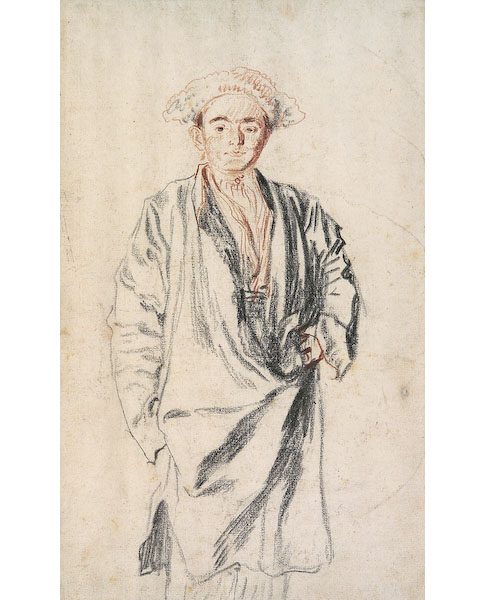
Watteau. Standing Man, 1715. Karlins:Watteau’s drawings played a central role in the composition of his paintings. Unlike artists who would make drawings as studies for paintings, Watteau tended to select existing drawings from his notebooks and adapt them for larger works. He would organize figures into groups, then arrange the groups in a landscape, which often owe a lot to Dutch or Italian art.
The importance of Watteau in our appreciation of the eighteenth century is greater than we realize. Without him we would have only a record of courtly affectations in the works of Boucher, of licentious charm in those of Fragonard, of modes in portraits and popular prints and, in Gainsborough’s canvases, an affectionate revelation of the natural warmth that exists in good people beneath frivolity and fashion. Without Watteau, Gainsborough would remain the century’s greatest painter; but even Gainsborough, for all his poetic touch, loses his essence if we try to regard him as much more than a single favored spokesman of eighteenth-century England. Watteau alone abstracted from the froth of his century an essence that, for all the particularity of its raw ingredients, rises above time and place.
In the reminiscences of people who held him in affection, Watteau’s carelessness, his untidiness, his impatience, and his fits of misanthropy and withdrawal are accepted as corollaries to his talent, and even as part of his charm. But Watteau was not a charmer by intention. He was an archetype of the kind of artist, familiar today, who has replaced the hard-working supercraftsman of the Middle Ages and early Renaissance, the god-philosopher of the high Renaissance, and the practical man of affairs of the seventeenth-century. He was the artist as a man not quite like the rest of us.
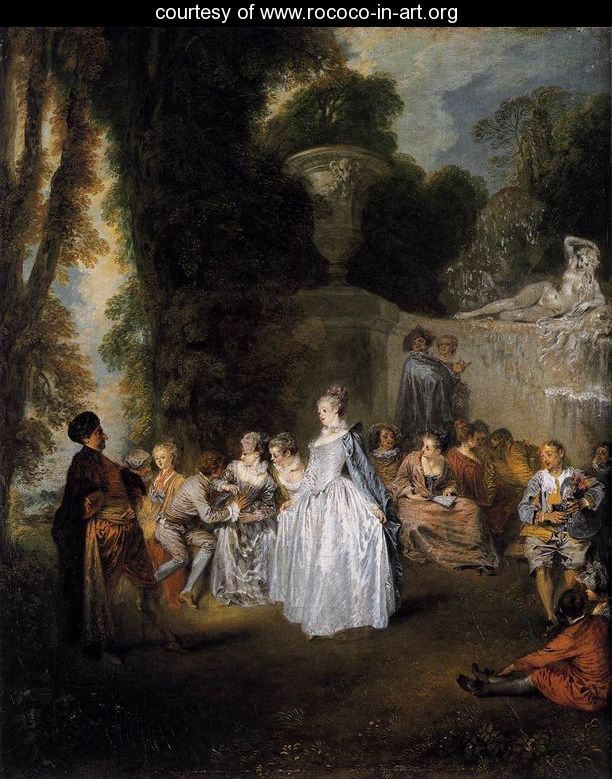
Watteau. Fetes Venetian. " The ballet as it developed at the Paris Opera around 1700 announced an aesthetic of modernism based on a radical freedom from the rules of classicism and traditional heroic themes, along with a celebration of the human body and its capacity for sensuous and virtuosic movement. As Sarah Cohen has demonstrated, the dances of the opera-ballet introduced a new kind of spatial play, defined by the galant interaction of couples and groups rather than by the central performing body of the king."
Watteau’s inability to cope with the world is inherent in a talent that must be nurtured and protected, and those who discover and patronize that talent are rewarded by the satisfaction of vicariously sharing his creative gift. Watteau’s patrons were that special type of “amateur” peculiar to the eighteenth century: professional men, financiers, or dilettantes whose avocation was patronage and collecting and who might enjoy the practice of an art, usually painting or engraving, as a serious hobby.
Jacques Callot’s superb theatricality, Ruben’s radiant glorification of color and of the flesh, and Titian’s poetization of all sensuous experience were to become the major outside influences in the expression of Watteau’s genius. The impact of Callot was immediate, in conjunction with a firsthand acquaintance with the “commedia dell’ arte” that Callot had celebrated. But at this time in Paris in the first decade of the eighteenth century, in a Paris that was not yet the city of public museums, Watteau must have seen very few paintings by Rubens and perhaps none by the Venetians. That had to wait until he knew the important collectors.
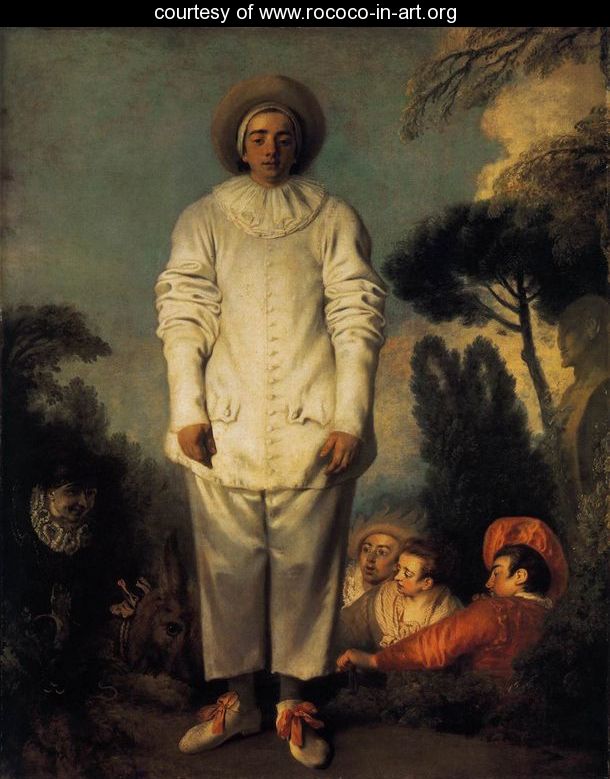
Julian Bell:The portrait of the pierrot Gilles may record a certain stage act of the 1710s, but equally it taps us into the revival of mime theater in 1830s Paris and the resuscitation of that revival in Marcel Carné's great film of 1945, Les Enfants du Paradis -- not to mention Cézanne's pictorial dalliances with pierrots in the 1880s, and Picasso's after the Great War. And these give us a larger sense of what Watteau was up to, for when Perl bounces back at length to consider the original figure, he can argue that in the great blank of his suit of white satin and the small blank of his radically irresolute face, Gilles suggests a characteristically modernist anxiety: White equals possibility -- the white paper to write on or draw on or compose on, the white canvas to paint on, but also the white of the empty gallery and the empty stage. For artists, this is the deep, primitive fascination of the white clown.... Gilles is raising a question about the possibilities of creation. How can I move from the nothingness of a beginning to the completeness of a work of art?... The quizzical, uneasy look on the clown's face is the look of the work of art that is not yet created, that is still wondering what it will be.
It is not known exactly when Watteau met Pierre Crozat, but with that meeting began the full realization of the Watteau we know. Crozat was not quite the richest man in France, but his brother Antoine was so rich as the result of his monopoly of the Louisiana trade that he was never able to estimate his wealth. But Pierre was rich enough. He was in his fifties when he met Watteau, and at forty-three had retired from business and purchased at a steep price the office of the Treasurer of France, with all the advantages involved. His palace and gardens in Paris were on the royal scale. He staged concerts and theatricals there for friends. His parties were famous, and although they seem to have been more sedate than the outrageous drunken revels of the aristocracy, they could hardly have been given over entirely to aesthetic cultivation.
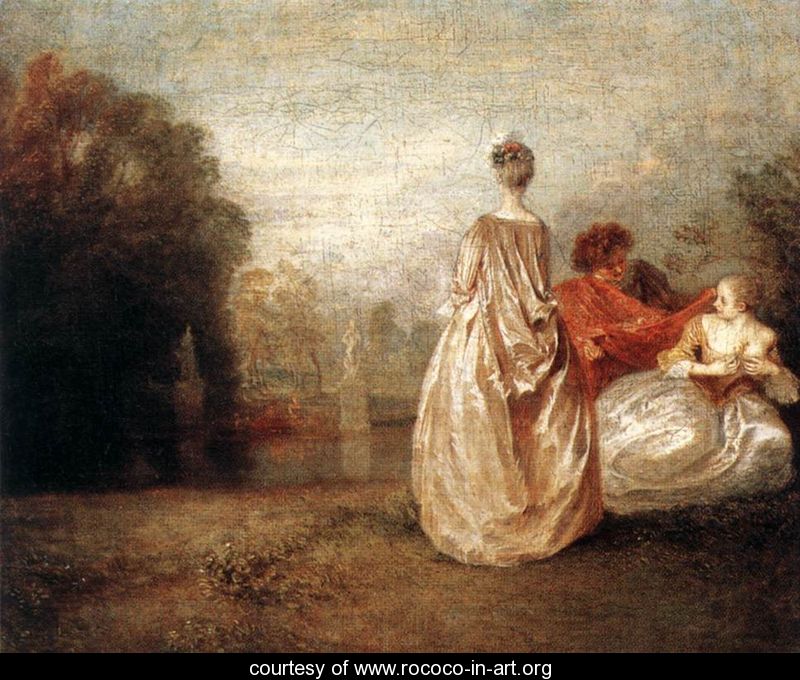
Watteau. Two Cousins. 1716. "...Yet the history of French painting will broadly bear them out: Watteau introduced just such a change of accent. His improvisations bade farewell to the objectives of completeness and coherence spelled out by Poussin in the previous century. Hints and indeterminacies dangled in their stead. A wonderful tiny canvas in the Louvre known as The Two Cousins features a park lake at evening. One couple is flirting by its bank, another lingers between distant statues reflected in its waters; but all turns on the back of a lone blonde in a shimmering yellow gown, standing at an anomalous angle to those others and presenting a vacant yet potent vehicle for our empathy. She is another blank, comparable to that offered by Gilles."
Crozat installed Watteau in an apartment in his palace. Crozat was an avid collector; among his five hundred paintings and nineteen thousand drawings there were, as a single breath-stopping example, about twenty-five paintings and three times as many drawings by Titian alone. Watteau was now surrounded by the paintings that were his true teachers, and he had access through Crozat, to the royal collections as well. While Crozat set about making him a fashionable painter, Watteau watched the gallantry of the garden parties that gave him his nominal subject matter, but it is difficult to think of him as part of the company. If he mingled, he remained psychologically removed, and after a year or so he left the palace, though there was no break with Crozat.
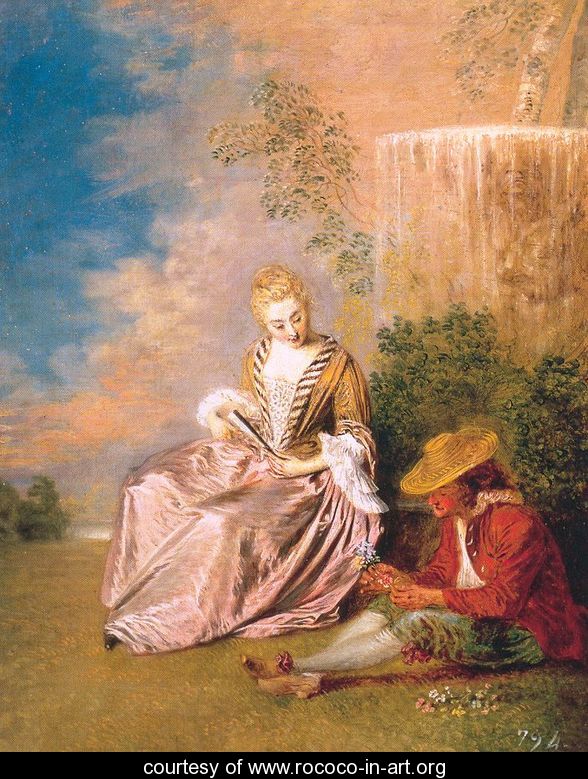
"Vidal argues that what Watteau depicts in his paintings is never the content of the conversations as something distinct from their form—never the pointed, instructional gestures of a Gainsborough painting that exaggerate things so as to render them readable, even to the (morally) unschooled. Rather, their secret knowledge is always embedded—a set of values (elegance, harmony with nature) is expressed in paintings that espouse those very values and posit conversation as an art of living. Vidal makes a strong case for considering the “naturalness” of the corseted aristocrats that Watteau painted in terms of being “God-given” and full of grace—something that might escape a contemporary (secular) eye which looks for naturalness in wildness or the absence of technology. The paintings are strange to us, perhaps because they do not reflect our values, but they are also somewhat unheimlich insofar as they point to the contemporary representation of conversation as the potential for creating a set of values, a common currency, a kind of network."
After Crozat had pushed his protegé to seek acceptance in the Academy, Watteau was, in 1717, accepted with the “Embarkation for Cythera” , his materpiece but a most unconventional presentation piece. With its gentle lovers strolling toward a gilded confection of a boat that will carry them to the realm of love-Watteau’s transmutation of the byplay of seduction- this poetic vision had nothing to do with the declamatory rhetoric expected of the candidate, and the Academy had to create a special category for Watteau: “Painter of Fetes Gallantes.” Watteau, may have confounded the jury by seemingly integrating an ideology established in the opera-ballet, in which he substitutes an iconography of a modernist, matriarchal Cythera for traditional modes of patriarchal encomium.
In the war between the Poussinists and the Rubenists that divided the academicians, Watteau’s election was considered a victory for the Rubenists; and so it was, for the fastidious Watteau and the robust Rubens, paradoxically had much in common. But it was more important in a way that was not noticeable at the time. A new force outside the Academy had challenged its dictatorial powers; the regime of the private patron and the personal artist had begun. Although Watteau’s election with so unconventional a painting involved no preliminary skirmish, the skirmishes were to occur and grow more and more frequent until finally the Academy’s defeat by the impressionists and their patrons would break its power forever.
ADDENDUM:
“These authors’ discussions on Watteau seemed to show the conflicts in their approaches most clearly; for me, the distinctions made by Crow and Bryson in their respective analyses helped to point problems that might not have been considered if I only had access to Bryson’s account. Bryson sees Watteau’s oeuvre as consisting of paintings which are a ‘semantic vacuum’; as they have no semiotic or narrative value, the audience has free reign to interpret the work, and can draw on a variety of sources, such as Watteau’s illness, to create a story. “Excess of Watteau writing is itself an interesting phenomenon, and one with more direct bearing on Watteau’s painting than one might think. Ultimately it is the natural reaction to an effect quite central to Watteau’s enterprise, which one might call the ‘semantic vacuum’” (Bryson ). Thus, for Bryson, Watteau’s art, as it is bereft of the semiotic system that was evident in academic works such as LeBrun’s, has no real semiotic value at all. In his mind, it is this ‘emptiness which is the characteristic and strength of Watteau’s painting.
The firsthand account of ( Comte de) Caylus seems to lend strength to Bryson’s argument. In his discussion, he notes that the work of Watteau is not well-suited to discursive painting and that his strengths lie in the ‘accidental’ qualities of his work. The skill of draughtsmanship, considered so vital to ‘discursive’ painting, was seen as poorly developed in Watteau.
( Thomas ) Crow grounds Watteau’s painting in an alternative narrative; for him, Watteau’s art represents the aristocracy’s subversion of ‘official’ forms of culture, ranging from the theater to the Academy itself. First, he outlines the aristocrats’ embrace of street culture and their subversion of the controls of the centralizing monarchy. Aristocratic society readily took up the ‘Italian’ street theater that was a popular competitor for the official theaters of the state. The Comédie italienne, once supported by the king, had been banished from the court; however, the performers were able to join street troupes, and thus the traditions of these groups lived on in low culture. Unlike the controlled classicist culture of the court, which denied sensuality, these performances stressed sensuality and were often vulgar in tone. “Street theater was quickly embraced by the aristocratic classes and provided competition for the official state theaters, despite attempts by the monarchy to undermine street theater through restrictions. “The popularity among the affluent of a theater where ‘all was permitted’ was sufficient to threaten the solvency, even the survival, of the legitimate theaters” (Crow ). More significantly, the elite even appropriated the performance of street theater through staging parades on balconies and performing in comedies as a hobby; such performances eventually took a life of their own, eventually becoming an ‘aristocratic’ form of expression. “Around 1710, amateur versions of Italian-style comedy became a favourite, not to say obsessive, pastime among the Parisian aristocracy, both in the city and more importantly in country pleasure parks outside it. And it was not the plays once staged by Italians at court or even the principal productions of the fair that fascinated elite enthusiasts; it was the knockabout farce of the parades that provided the model and texts for these private performances” (Crow ). The nobility had begun to distance itself from the court politically, and found in the culture of street theater a way to assert its independence in a cultural sphere. This emerging aristocratic ‘text’, based on the bawdy and sensual ‘Italian’ street theater, would provide the basis for Watteau’s oeuvre.
When the background of this subversive aristocratic culture is understood, Bryson’s interpretation of Watteau’s art as discursively empty loses much of its power. “Once we take account of this kind of behavior and its penetration into elite sociability, it becomes difficult to see Watteau’s fête galante as a purely personal theater, a fantastic transformation of prosaic experience” (Crow). Rather than being ‘empty’ images on which the audience can transcribe the mythical artist, Watteau’s paintings take up the language and text of the aristocracy, which, while marginalized by official bodies, nonetheless exists as a discursive entity. Many of his paintings are replete with symbols of the sexuality of the comedy and parade; motifs such as bagpipes and monkeys as well as ‘Italian’ characters such as Columbine and Pierrot make frequent appearances, and the treatment of paint also underlies the themes of sensuality. Works such as Fêtes vénitiennes could create a scene which was as allegorical as the paintings of an academic like LeBrun. “Watteau can allude to the erotic obsessiveness which was an inescapable part of his subject… This dispersed collection of signs functions to a significant degree independently of the ‘scene’ before us. Its allegories guarantee its status as fiction, as a work of and for the imagination” (Crow ). As the aristocracy subverted the monarchy, the art of Watteau served to subvert the ‘universal’ discourse and symbolic systems of academic art by providing an alternative discourse based in ‘feminine’ virtues of sensuality rather than the ‘masculine’ virtues of war.
